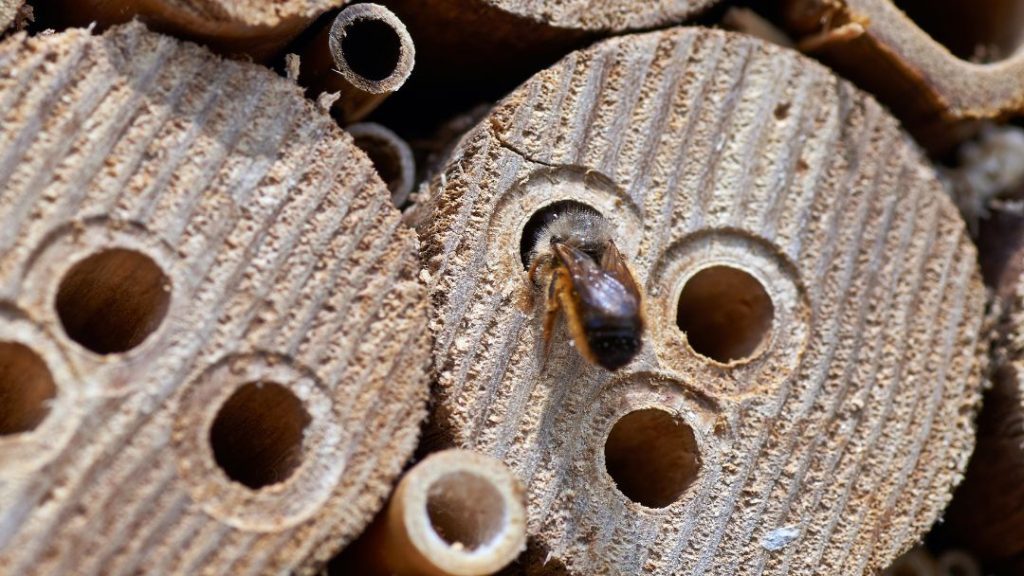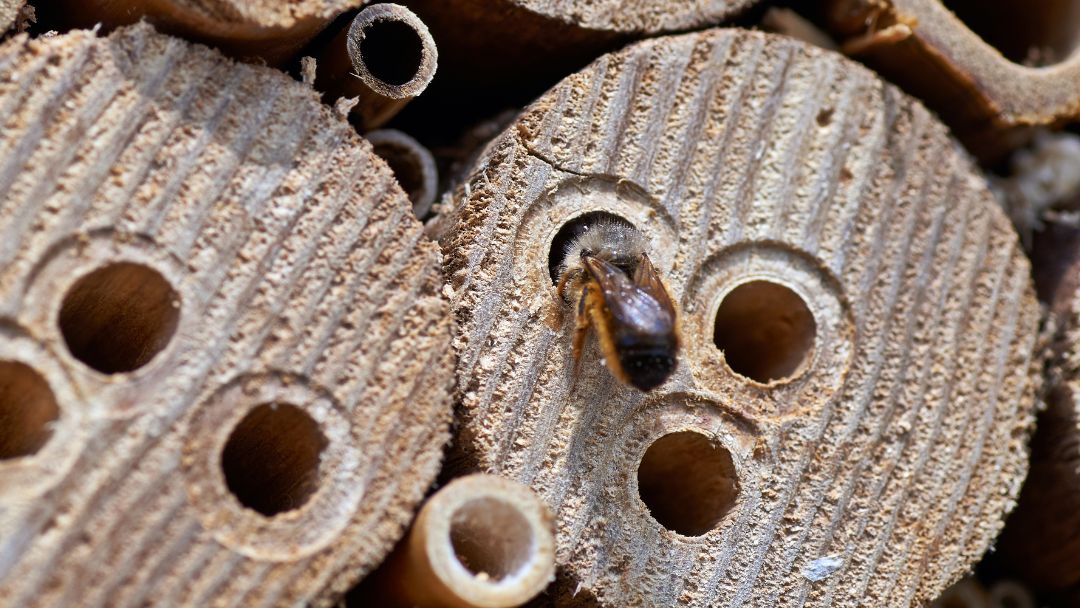What Size Holes For Mason Bee House?
Mason bee house comes in different sizes of holes. Have you ever wondered what size holes for mason bee houses are the best?
Should you use large, medium, or small holes for these non-colonizing solitary bees? Do masonry bees prefer skinning or wide tunnels for nesting?
Masonry bees generally prefer 1/4 to 3/8-inch wide holes for nesting. The nesting area should be spacious enough to accommodate 5-6 eggs, a minimal amount of pollen, and enough mud to seal the tube.
In this article, you will get a complete overview of this topic.
What Size Holes For Mason Bee House?
These non-colonizing solitary bees are around 3/8 to 5/8 inch or 7 to 15 millimeters long. Generally, female mason bees are larger than males.
Each hole in a mason bee house should be around 1/4 to 3/8 inch wide. The width of the hole looks similar to a pencil.
Plus, it must be at least 5 inches deep. But, 6-7 inches deep holes are better to accommodate more number of larvae.

How Many Holes For Mason Bees?
Each female mason bee needs at least 5 empty holes in the mason bee house. You must be wondering why each solitary bee prefers these numbers of cavities, right?
A female mason bee lays around 20-30 eggs in her lifetime when they are active for 4-6 weeks. A single hole can hold around 5-6 eggs.
Apart from the eggs, female mason bees add pollen as a future food source for the eggs.
Besides, each hole is divided into several chambers. A chamber consists of a single egg and a small amount of pollen. Finally, the development chamber is sealed up with mud.
Hence, each chamber will cover around 1 inch of space, including the egg, pollen, and mud.
You can do the calculation. If 5 eggs are for each hole, a mason bee needs around 5-6 holes in a mason bee hotel.
Do Male And Female Mason Bees Need The Same Hole Diameter?
Yes, both male and female mason bees need the same hole diameter if there are 3 males and 3 females emerge from each hole.
But, if more females have emerged than males from a single hole, the diameter should be a few millimeters long and one or two millimeters wide to accommodate more males.
Mason bee houses are mainly for storing eggs, keeping pollen, and adding mud. When a solitary bee lays eggs, it can be male or female.
Generally, there are 60% male and 40% female in mason bee house. Their sex ratio is 1.5 to 2 males per female.
More males are required than females to lay eggs. Plus, males have a shorter lifespan than females.
Do Mason Bees Mate Inside The Holes?
Male and female masonry bees don’t use the holes in their nests for mating. Instead, they prefer mating outdoors in their natural environment.
Female mason bees start mating immediately with male mason bees once they emerge.
Male bees might be waiting at the exit area of the mason bee house or flying around the nest.
Males will engage in a courtship dance to attract catch queens’ attention. They will attempt to mate with females in mid-air. Their perching spots are sometimes referred to as “mating stations.”
After completing mating with one female, the male will wait for another female to emerge. They can mate as many times as they wish. Males usually die within 4-6 weeks.
How To Drill Holes In Mason Bee House?
Drilling the holes as deep as possible is a good rule of thumb. Drill the holes up the length of your wood block.
You can use a drill press to create holes in the wood blocks of a mason bee house.
A single pass can cover around 2-inches or 3-inches of depth. Hence, you need to drill each wood block or post several times to reach the maximum depth.
Don’t forget to smooth out the edges of the freshly drilled holes using a piece of sandpaper.
It will allow mason bees to enter and exit the hole comfortably. Otherwise, the sharp edges may injure them.
Another vital task is adding a piece of cement board at the back of the wood post. It will prevent birds and other larger bees from entering the holes.
Most importantly, cleaning the holes will be easier. Make sure to secure the board with some weather-resistant screws.
How Many Holes For A Mason Bee House?
There are no hard and fast rules regarding the number of holes for a single mason bee house.
However, expert beekeepers recommend keeping not more than 250 female mason bees for each mason bee hotel.
A female mason bee needs around 3-5 holes, cavities, or reeds. Hence, each mason bee house requires at least 750 holes to accommodate 250 females.
This approach appears practical for giant-sized mason bee houses. Besides, you have to ensure enough plants. One acre of apples or cherries is necessary for 250-300 females.
It is best to keep 100-200 holes for each mason bee nest. This helps you avoid overcrowding each Mason bee home.
You can install several smaller or medium mason bee nests to accommodate all these non-colonizing solitary bees.
Are Holes, Tubes, Or Reeds Better For Mason Bees?
Mason bees generally prefer phragmite reeds and bamboo/cardboard tubes over drilled wooden holes.
These non-colonizing solitary bees are fans of natural reeds due to their attractive appearance. Their distinctive surface texture allows bees to recognize their particular nesting site easily.
Natural reeds are easier to split for cocoon transfer and safer than craft paper rolls. Cavity-nesting bees love phragmite reeds as they can naturally wick away moisture.
Masonry bees may not like drilled wooden holes, especially if there are any rough spots. Wood splinters may damage the cocoons.
If you have no option but to use drilled wood blocks, make sure to add paper inserts inside them.
Some experts don’t recommend using bamboo tubes and glass/plastic straws because they retain moisture due to a lack of breathing and promote mold growth.
However, you can use SipSticks paper straws, which are made from breathable materials and don’t promote mold development.
What Is The Best Diameter For Mason Bee Tubes?
This question has no direct answer due to a lack of research and reliable data. However, some long-term beekeepers shared their experiences that many mason bees picked 5-6 mm holes over the much larger 7-8 mm holes. Few have chosen 5 mm holes over 4mm holes.
But why do mason bees prefer smaller holes than larger ones? A straightforward answer is that cells found in natural combs are not as big as man-made ones.
Artificial tunnels or drilled holes have slightly larger diameters than cells found in natural combs. Some bee raisers think that providing a bit larger diameter holes can help to produce larger bees.
However, many experienced beekeepers shared their thoughts that artificial houses are prone to attract diseases and parasites.
What Is The Advantage Of Large Diameter Holes?
Mason bees may prefer small-diameter holes to the larger options to some extent.
But if all the holes are wider than natural cells, it can provide several benefits. Of course, you want to ensure a safe and comfortable environment for them.
Larger Tubes Result In Larger Bees
According to the Sustainable Agriculture Research and Education article, larger holes can help female mason bees produce larger bees, and smaller holes lead to smaller bees.
This special research figured out that smaller tubes increase the number of males than females from eggs.
More Comfortable Environment
Large-diameter holes have more space to turn around. Mason bees can store more food inside the wide tunnels.
They can add more pollen and mud to it. Mason larvae will receive enough food until they emerge.
Small diameter holes can be challenging for mason bees. They will struggle to move around. Plus, shaping the pollen into larval food pellets will be difficult.
Less Tubes Or Holes
Large and long-diameter holes can accommodate more mason bees than small and shorter options.
Hence, these non-colonizing solitary bees can lay more eggs in each tunnel. You will have to use less number of tubes or holes. It allows you to utilize the space more efficiently.
Do All Mason Bee Species Need The Same Hole Size?
There are more than 300 species of mason bees available globally. In fact, North America has about 140 species of mason bees.
Orchard, Osmia californica, Osmia bicolor, Osmia bicornis, Osmia atriventris, Osmia cornifrons, Osmia cornuta, etc. are some common ones.
These various species of mason bees differ in size, coloration, nesting habits, flight season, foraging preferences, geographical distribution, lifecycle, mating behavior, cocoon appearance, etc.
It is best to study properly before deciding the hole’s size. Research what sizes are the best choice for your native mason bees. If you are growing various species of solitary bees, keep a variation in the hole diameter, too.
Conclusion
Are you still wondering what size holes are for mason bee house? Mason bees are hard-working, non-colonizing solitary bees. They can adapt to various environmental conditions. You can combine small, medium, and large holes to accommodate multiple species of masons.
However, smaller tunnels are likely to be filled up faster than larger tunnels. You can gradually push them to accept and use large-sized holes in mason bee houses. But don’t exceed their tolerance level. Mason bees will love to build nests in blocks of nicely prepared tunnels.


